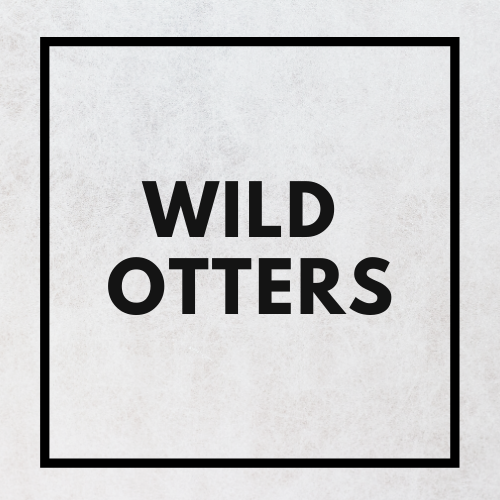Wild Otters
Threatened and traded
by Gwyneth ChengOn a good day, you may easily find wild otters roaming the riversides of Singapore. Known and loved for their adorable looks and charisma, otters are fancied by locals and tourists alike.

Yet, despite all the attention being paid to them, many of us aren’t truly aware of the dark issues otters face. People are far more likely to tell you the best places to spot our furry friends in Singapore than know that the very same species we see here are killed and traded in large numbers across Asia and the world.
This has, unfortunately, always been a big problem. We know that charismatic wildlife have long been traded as pets and consumed for their body parts. In the fight against the wild mammal trade, rescue efforts often have to narrow in on larger, higher-profile mammals such as tigers, elephants, and rhinoceroses. This means smaller but equally threatened mammals such as otters are often overlooked.

These adorable creatures we know and love have actually been traded for centuries. Time and time again, several otter species have been driven to the brink of extinction solely due to human greed and demand.
Despite its long history, the magnitude of the otter trade in Asia was only uncovered around 15 years ago. Huge quantities of otter skins were accidentally found during a 2006 investigation of the big cat trade, when otter skins were spotted displayed beside the pelts of tigers and leopards.

Further investigation later uncovered that Asia contains the biggest market for otters.
Most of the otter species traded in Asia are native to the region—which isn’t surprising, since traders can hunt them here easily. Some of these species may look familiar to us; others, not so much. Sadly, most are vulnerable or endangered, and all have experienced a decline in population numbers over the past thirty years.
Over the past four decades, around 15 Asian countries have been involved in the otter trade.
South Asia, in particular, is a hotspot—in Afghanistan, Bangladesh, India, and Nepal, otters are intensely hunted for their body parts. In the 2000s, otter skins made up around 30 percent of the fur trade in India, and their largest consumer was another Asian country: China.
Other parts of Asia aren’t guiltless, though. Japan, South Korea, and Russia all have major otter markets.
Seizures of otters, as well as source and destination of trade, in Asia. Source: CITES trade database
The world is now more connected than ever, and this has allowed the relentless expansion of the online exotic pet trade. Physical markets have been replaced with “virtual internet marketplaces”, in which the sale of wildlife takes place even more efficiently and slips past detection more easily.
Legal or illegal, anything goes in these digital markets. Live reptiles, amphibians, and birds, as well as products derived from large mammals such as elephants, tigers, and rhinoceroses, are traded on far-reaching platforms like Facebook, eBay and Amazon way too easily. Of course, live otters and their parts are included in the mix.
Worse, social media has enabled a new kind of advertising—the spread of viral pet videos, often of exotic animals being adorable or doing some nature-defying feat. Exotic pet owners have accounts with thousands of followers, their pets akin to social media influencers themselves. It all seems like fun and games, but the reality is worrying—the more people are attracted to such content, the more the demand for exotic animals in the wildlife trade grows.
Moreover, sellers don’t even need to wait for content to go viral—the advertising features of most social media platforms allow them to convey their messages to millions around the world. Right now, most social media platforms don’t have the algorithms needed to successfully suss out such content. From January to May 2012 alone, 46 Indonesian online sellers posted 63 advertisements. Each advertisement touted around one to four otter pups.
While there’s a lot left to tackle with the global wildlife and otter trade, a lot of good, effective work has been done in this fight.
For instance, there has been more protection for otters in the legal, international trade. CITES plays a huge role here, and it’s why efforts have been centered around altering and improving CITES regulations. Depending on which Appendix they’re on, different otter species get different levels of protection from trade.
In 2019, research by TRAFFIC, the IUCN Otter Specialist Group, as well as several partner organisations contributed to CITES’s decision to push the smooth-coated otter and small-clawed otter up from Appendix II to Appendix I. This means that commercial trade of these two species is no longer allowed, unless it happens under exceptional circumstances.
Across the world, various national and regional laws serve to protect otters and their habitats, too.
National protective laws for otters across Asia. Source: TRAFFIC
Things are looking hopeful for otters, but wildlife organisations aren’t willing to slow down just yet, as illegal trade still continues.
Not all otters native to Asia enjoy the same level of protection. This creates a huge problem in enforcement—regulation officers have a difficult time checking for species prohibited from trade, especially when the otters have already been killed and arrive as crates of body parts.
Moreover, with social media platforms speeding up the growth of the wildlife trade, law enforcement has been struggling to catch up. New methods are constantly required to monitor and regulate these online markets, but they often fall short due to the fast-paced nature of what they’re dealing with.
Clearly, stopping the otter trade is a monumental feat.
International organisations such as TRAFFIC, the IUCN Otter Specialist Group, and the International Otter Survival Fund have been involved in curbing both legal and illegal trade. Respective national efforts, including Wild Otters in India and the Otter Working Group in Singapore, also contribute by being involved in research as well as educating the public on the importance of keeping otters in the wild.
But we don’t have to leave it to them. Our access to the internet as well as social media allows us to have eyes on the situation, too. Reporting illegal wildlife and associated items on e-commerce sites, along with social media accounts that sell or advertise exotic pets, could chase sellers off these platforms. Many websites don’t actively attempt to root out the illegal sale of wildlife and their products, but will remove listings if the items are reported by consumers.
Oh, and don’t promote viral animal videos to your peers or follow influencer pet accounts, either! If you wish to share and spread otter content, choose works that support keeping otters in the wild—like the posts on The Otter Collective, an initiative by Wild Otters that shares art instead of viral videos. All these efforts help curb demand for exotic pets at its root.
The otter trade has been a hidden blemish in our history for decades here in Asia. Now that it’s exposed, we can ensure that it can no longer get away unnoticed—giving us a hopeful chance to wipe out this blemish for good.
Julia is a freelance data journalist, data visualization designer/developer and cartographer with a focus on environmental issues, biodiversity conservation, democracy and human rights. Julia is from the U.S. and Taiwan, and currently lives in Paris. Her academic background is in conservation biology, entomology, remote sensing and Japanese. Julia is also currently working on Taiwan Data Stories as a side project.
Wild Otters Research is an entrepreneurship founded in 2018, with three core verticals in mind: wildlife research, education and outreach. Our projects aim to fill data deficiencies in the current knowledge of various species, and collaborate with local communities and authorities to facilitate better understanding of our environment and the importance of conservation. We are members of the IUCN SSC Otter Specialist Group, an international community of researchers supporting otter conservation efforts around the world.












